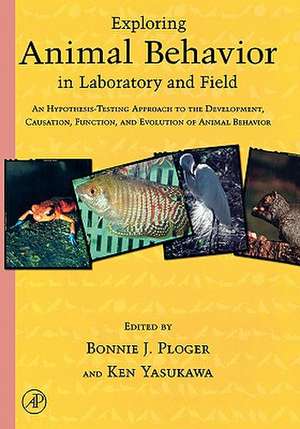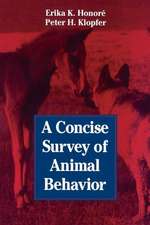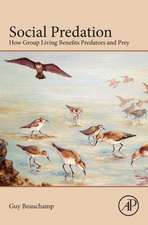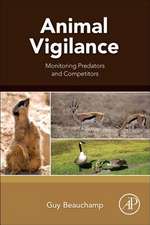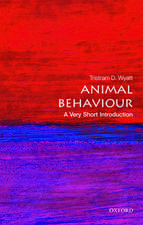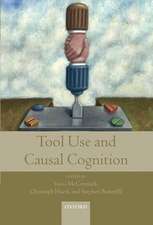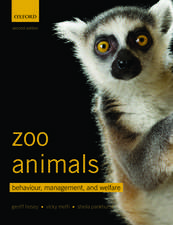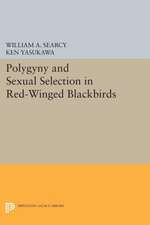Exploring Animal Behavior in Laboratory and Field: An Hypothesis-testing Approach to the Development, Causation, Function, and Evolution of Animal Behavior
Editat de Bonnie J. Ploger, Ken Yasukawaen Limba Engleză Paperback – 12 noi 2002
* Supports a range of pedagogical styles and texts in animal behavior with active learning experiences that engage students
* Students and instructors benefit from knowledge and experience of members of the Animal Behavior Society
* Flexibility of design enables students and instrucotrs to tailor the exercises to their needs
* Can be used to support lab courses that are completely inquiry based as well as independent student research projects in animal behavior
* Consideration of animal care guidelines provides an excellent way to address and discuss concerns about the use of animals in teaching and research
* Emphasizes the hypothetico-deductive approach that students have difficulty understanding and implementing
* Supporting materials make additional required texts unnecessary and link study design considerations with real studies
Preț: 326.67 lei
Preț vechi: 433.14 lei
-25% Nou
Puncte Express: 490
Preț estimativ în valută:
62.51€ • 65.43$ • 52.03£
62.51€ • 65.43$ • 52.03£
Carte tipărită la comandă
Livrare economică 24 martie-07 aprilie
Preluare comenzi: 021 569.72.76
Specificații
ISBN-13: 9780125583305
ISBN-10: 0125583303
Pagini: 472
Dimensiuni: 175 x 254 x 22 mm
Greutate: 0.83 kg
Ediția:New.
Editura: ELSEVIER SCIENCE
ISBN-10: 0125583303
Pagini: 472
Dimensiuni: 175 x 254 x 22 mm
Greutate: 0.83 kg
Ediția:New.
Editura: ELSEVIER SCIENCE
Public țintă
Students in Animal Behavior and Behavioral Ecology. The readership of Animal Behaviour is an important audience and includes over 5000 subscribers.Cuprins
CONTRIBUTORS
PREFACE
PART 1. INTRODUCTION
PART 2. DESCRIBING BEHAVIOR
1. Learning to describe and quantify animal behavior
B.J. Ploger
2. Developing operational definitions and measuring interobserver reliability using house crickets (Acheta domesticus)
T. Glover
PART 3. CAUSATION
3. Courtship, mating, and sex pheromones in the mealworm beetle, Tenebrio molitor
E. Font and E. Desfilis
4. Courtship and mate attraction in parasitic wasps
R.W. Matthews and J.R. Matthews
5. Chemoreception in lizards
C. O'Neil Krekorian
6. Behavioral thermoregulation in field populations of amphibian larvae
H.H. Whiteman and N. Buschhaus
7. Temperature dependence of the electric organ discharge in weakly electric fish
G.K.H. Zupanc, J.R. Banks, G. Engler and R.C. Beason
8. Observing and analyzing human nonverbal communication
P.L. Bernstein
9. Foraging behavior of ants, or picnics: an ant's eye view
S.L. Halkin
10. Hummingbird foraging patterns: experiments using artificial flowers
A. Inman
11. Honey bee foraging behavior
M.R. Richter and J.M. Keramaty
12. Individual constancy to color by foraging honeybees
P.S.M. Hill and H. Wells
PART 4. DEVELOPMENT
13. Dog training laboratory: applied animal behavior
L.L. Gillie and G.H. Waring
14. Paternal care and its effect on maternal behavior and pup survival and development in prairie voles (Microtus ochrogaster)
B. McGuire
15. The effect of prenatal visual stimulation on the imprinting responses of domestic chicks: an examination of sensitive periods during development
W.L. Hill
16. Development of thermoregulation in altricial rodents
G.R. Michener and T.D. Charge
17. Aggregation and kin recognition in African clawed frogs, Xenopus laevis
K.L. Anderson and B.J. Ploger
PART 5. ADAPTATION AND EVOLUTION
Section I: Foraging
18. Diving birds: a field study of benthic and piscivorous foragers
J.J. Templeton & D.J. Mountjoy
19. Found a peanut: foraging decisions by squirrels
S.L. Halkin
20. Economic decisions and foraging tradeoffs in chickadees
R.L. Mumme
21. Seed selection by foraging birds
M.R. Richter, J.A. Halstead and K. Savastano
22. Competitive behavior of birds at feeders
A. Mostrom
Section II: Avoiding Predators
23. Vigilance and the group-size effect: observing behavior in humans
J.E. Scheib, L.E. Cody, N.S. Clayton and R.D. Montgomerie
24. The function of "chat" calls in northern mockingbirds (Mimus polyglottos): vocal defense of nestlings
C.A. Logan
25. Diving and skating in whirligig beetles: alternative antipredator responses
A. Inman and A. Houtman
26. The response of tree squirrels to conspecific and heterospecific alarm calls
A. Houtman
Section III: Agonistic Behavior
27. Competition for breeding resources by burying beetles
M.P. Scott
28. Learning to be winners and losers: agonistic behavior in crayfish
E.M. Jakkob and C.D. Hoefler
Section IV: Courtship and Parental Care
29. Costs and benefits of maternal care in earwigs
R.L. Mumme, J.O. Palmer and S.M. Ranking
30. Vocal behavior and mating tactics of the spring peeper (Pseudacris crucifer): a field exercise in animal behavior
D.C. Forester
31. The role of multiple male characters in mate choice by female guppies (Poecilia reticulata)
D.J. Albrecht
32. Investigating human mate choice using the want ads
M. Crowe
Section V: Games
33. Demonstrating strategies for solving the prisoner's dilemma
K.N. Morgan
34. Using empirical games to teach animal behavior
P.K. Stoddard
Section VI: Evolution
35. The evolution of behavior: a phylogenetic approach
K. Yasukawa
APPENDICES
A. Guidelines for the treatment of animals in behavioral research and teaching
Animal Behavior Society and the Association for the Study of Animal Behavior
B. Ethical use of human subjects
American Psychological Association
C. Introduction to statistics
B.J. Ploger and K. Yasukaw
PREFACE
PART 1. INTRODUCTION
PART 2. DESCRIBING BEHAVIOR
1. Learning to describe and quantify animal behavior
B.J. Ploger
2. Developing operational definitions and measuring interobserver reliability using house crickets (Acheta domesticus)
T. Glover
PART 3. CAUSATION
3. Courtship, mating, and sex pheromones in the mealworm beetle, Tenebrio molitor
E. Font and E. Desfilis
4. Courtship and mate attraction in parasitic wasps
R.W. Matthews and J.R. Matthews
5. Chemoreception in lizards
C. O'Neil Krekorian
6. Behavioral thermoregulation in field populations of amphibian larvae
H.H. Whiteman and N. Buschhaus
7. Temperature dependence of the electric organ discharge in weakly electric fish
G.K.H. Zupanc, J.R. Banks, G. Engler and R.C. Beason
8. Observing and analyzing human nonverbal communication
P.L. Bernstein
9. Foraging behavior of ants, or picnics: an ant's eye view
S.L. Halkin
10. Hummingbird foraging patterns: experiments using artificial flowers
A. Inman
11. Honey bee foraging behavior
M.R. Richter and J.M. Keramaty
12. Individual constancy to color by foraging honeybees
P.S.M. Hill and H. Wells
PART 4. DEVELOPMENT
13. Dog training laboratory: applied animal behavior
L.L. Gillie and G.H. Waring
14. Paternal care and its effect on maternal behavior and pup survival and development in prairie voles (Microtus ochrogaster)
B. McGuire
15. The effect of prenatal visual stimulation on the imprinting responses of domestic chicks: an examination of sensitive periods during development
W.L. Hill
16. Development of thermoregulation in altricial rodents
G.R. Michener and T.D. Charge
17. Aggregation and kin recognition in African clawed frogs, Xenopus laevis
K.L. Anderson and B.J. Ploger
PART 5. ADAPTATION AND EVOLUTION
Section I: Foraging
18. Diving birds: a field study of benthic and piscivorous foragers
J.J. Templeton & D.J. Mountjoy
19. Found a peanut: foraging decisions by squirrels
S.L. Halkin
20. Economic decisions and foraging tradeoffs in chickadees
R.L. Mumme
21. Seed selection by foraging birds
M.R. Richter, J.A. Halstead and K. Savastano
22. Competitive behavior of birds at feeders
A. Mostrom
Section II: Avoiding Predators
23. Vigilance and the group-size effect: observing behavior in humans
J.E. Scheib, L.E. Cody, N.S. Clayton and R.D. Montgomerie
24. The function of "chat" calls in northern mockingbirds (Mimus polyglottos): vocal defense of nestlings
C.A. Logan
25. Diving and skating in whirligig beetles: alternative antipredator responses
A. Inman and A. Houtman
26. The response of tree squirrels to conspecific and heterospecific alarm calls
A. Houtman
Section III: Agonistic Behavior
27. Competition for breeding resources by burying beetles
M.P. Scott
28. Learning to be winners and losers: agonistic behavior in crayfish
E.M. Jakkob and C.D. Hoefler
Section IV: Courtship and Parental Care
29. Costs and benefits of maternal care in earwigs
R.L. Mumme, J.O. Palmer and S.M. Ranking
30. Vocal behavior and mating tactics of the spring peeper (Pseudacris crucifer): a field exercise in animal behavior
D.C. Forester
31. The role of multiple male characters in mate choice by female guppies (Poecilia reticulata)
D.J. Albrecht
32. Investigating human mate choice using the want ads
M. Crowe
Section V: Games
33. Demonstrating strategies for solving the prisoner's dilemma
K.N. Morgan
34. Using empirical games to teach animal behavior
P.K. Stoddard
Section VI: Evolution
35. The evolution of behavior: a phylogenetic approach
K. Yasukawa
APPENDICES
A. Guidelines for the treatment of animals in behavioral research and teaching
Animal Behavior Society and the Association for the Study of Animal Behavior
B. Ethical use of human subjects
American Psychological Association
C. Introduction to statistics
B.J. Ploger and K. Yasukaw
